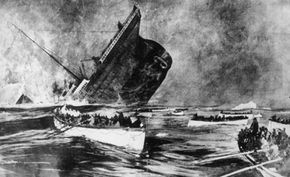Iceberg Danger
There is not, nor is there ever likely to be, an iceberg as famous as the nameless chunk of Arctic ice that gouged the side of the RMS Titanic in April 1912. Built to be "unsinkable," the ship struck an iceberg on her maiden voyage. Rather than striking head-on (which the ship likely would have survived), the ship grazed the iceberg below the waterline, creating a long gash that allowed water into multiple compartments. As the ship slowly filled with water, passengers fled on lifeboats. But there weren't enough lifeboats for all aboard, and the strange, slow pace at which the disaster unfolded led many lifeboats to be launched partly full, because passengers didn't think the situation was that serious [source: Eaton]. The result: 1,500 people lost their lives in the icy North Atlantic waters a few hundred miles south by southeast of St. John's, Newfoundland (accounts vary on the exact number of casualties).
The loss of the Titanic would have far-reaching effects. The area known as Iceberg Alley lies off the coast of Newfoundland, almost precisely where the Titanic went down. Fourteen passenger liners sank there between 1882 and 1890 [source: Bryant]. In the wake of the Titanic disaster, an international agreement led to the formation of the International Ice Patrol. Administered by the U.S. Coast Guard, the Ice Patrol keeps a close watch over Iceberg Alley, warning shipping traffic away from the "limit of all known ice," the area where the patrol believes ice presents a serious danger. They report not a single loss of life or property outside the limit in all the years they have been active [source: International Ice Patrol].
Advertisement
The International Ice Patrol sends out flights of C-130 Hercules aircraft to find icebergs. They also collect ice-sighting data from ships in the area. All the information is fed into a computer that uses tracking models and oceanic current information to estimate where the known icebergs will float to and when they'll get there. They provide this information via the Internet and radio to all nearby ships. In addition, advanced radar systems on each ship can spot larger bergs miles away, even in fog or storms. While the problems caused by icebergs have dropped dramatically since the early 20th century, the risk will never disappear completely.
The Coast Guard has experimented with different ways to track icebergs, including spraying them with brightly colored dyes or planting radio transmitters on them. They've even tried different ways to destroy icebergs, mostly by dropping bombs on them [source: International Ice Patrol].
If you'd like to learn more about icebergs and other topics like it, try the next page.
Related HowStuffWorks Articles
- Disappearing Lake Quiz
- How an Ice Hotel Works
- How Avalanches Work
- Harrowing Survival Stories
- How to Survive the Freezing Cold
- Taken by the Sea: 11 Real-life Shipwrecks
- How Water Works
- How the Earth Works
- How Radar Works
- How the U.S. Coast Guard Works
- Exactly what happens if we run out of water?
- How can a lake simply disappear?
More Great Links
Sources
- Bindschaldler, Robert. "Alaskan storm cracks giant iceberg to pieces in faraway Antarctica." NASA Goddard Space Flight Center, Oct. 2, 2006. http://www.physorg.com/news79026480.html
- Bridges, Andrew. "Enormous Icebergs Imperil Penguins Heading For Antarctica Breeding Grounds." Space.com, Dec. 28, 2001. http://www.space.com/scienceastronomy/planetearth/penguins_berg_011228.html
- Bryant, Edward. Natural Hazards. Cambridge University Press, 2005.
- Collins, Paul. "The Floating Island." Cabinet Magazine, Summer 2002. http://www.cabinetmagazine.org/issues/7/floatingisland.php
- Durkin, Pat. "Keeping Tabs on Icebergs." National Geographic News, Dec. 26, 2000. http://news.nationalgeographic.com/news/2000/12/1226_iceberg.html
- Eaton, John P. & Haas, Charles A. Titanic: Destination Disaster : The Legends and the Reality. W. W. Norton & Company, 1987.
- Hult, John L. & Ostrander, Neill C. "Antarctic Icebergs as a Global Fresh Water Resource." http://www.rand.org/pubs/reports/R1255/
- International Ice Patrol. "International Ice Patrol (IIP) Frequently Asked Questions." http://www.uscg.mil/lantarea/iip/FAQ/FAQ_Icebergs.shtml
- International Ice Patrol. "International Ice Patrol Mission." http://www.uscg.mil/lantarea/iip/General/mission.shtml
- International Ice Patrol. "Photo Gallery - Iceberg Destruction Experiments." http://www.uscg.mil/lantarea/iip/Photo_Gallery/Iceberg_Destruction_Experiments_1.shtml
- Simon, Seymour. Icebergs and Glaciers. HarperTrophy, 1987.
- Stone, Gregory S. Ice Island: The Expedition to Antarctica's Largest Iceberg. Bunker Hill Publishing, 2003.
- "Ferry Abandoned." Charleston Daily Mail, June 3, 1977.
- "Mystery of Rare Emerald Icebergs Is Solved." New York Times, May 4, 1993. http://query.nytimes.com/gst/fullpage.html?res=9F0CE7DF133EF937A35756C0A965958260
